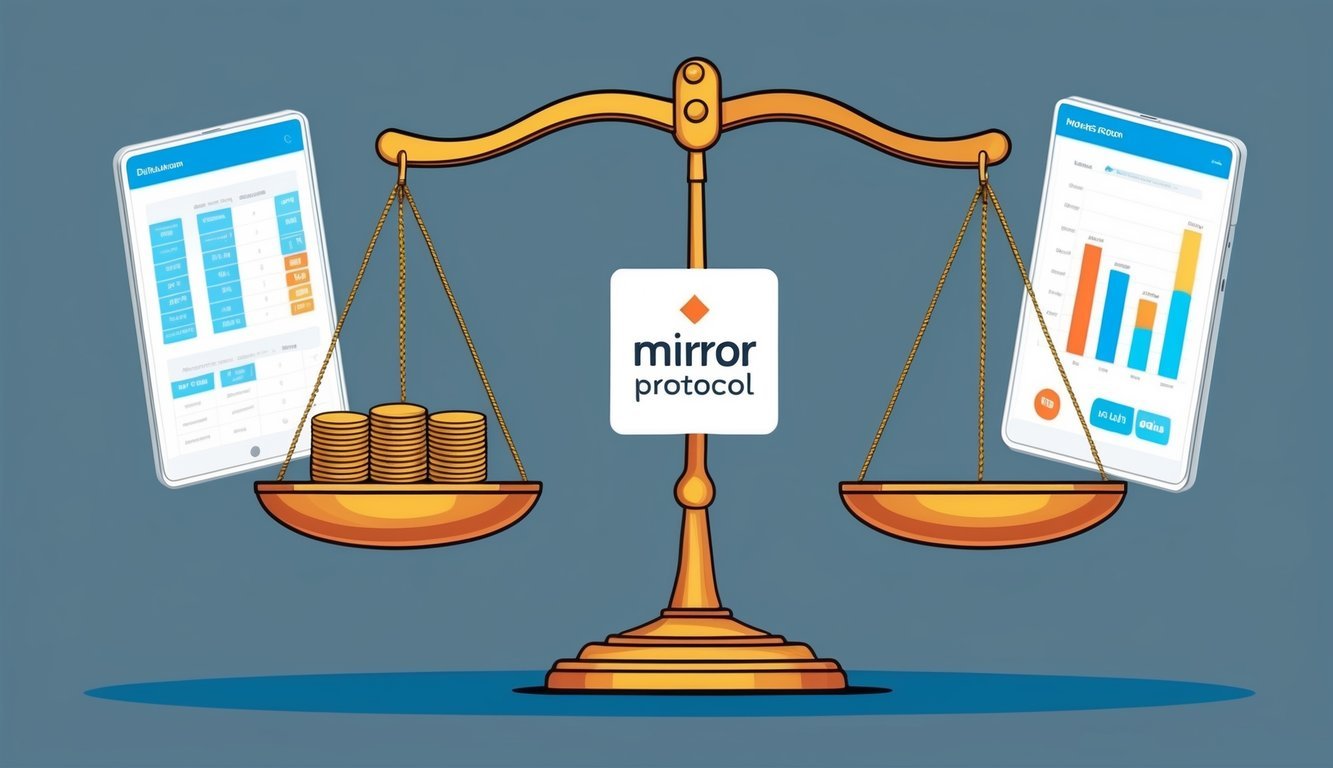Mirror Protocol is a cool way to get into traditional finance using crypto. It lets you create and trade synthetic versions of real-world assets like stocks and commodities on the blockchain. This means you can get exposure to things like Tesla or Apple shares without actually owning them.

The protocol runs on the Terra blockchain and uses smart contracts to make all this happen. You can mint these synthetic assets, called mAssets, and trade them just like you would regular crypto tokens. It’s pretty neat because it brings together the worlds of traditional finance and decentralized finance (DeFi).
MIR is the token that powers the whole Mirror Protocol ecosystem. You can use it to vote on changes to the protocol and participate in its governance. It’s a way for users to have a say in how the platform develops and grows over time.
Key Takeaways
- Mirror Protocol lets you trade synthetic versions of real-world assets on the blockchain
- You can create and trade mAssets without owning the actual underlying assets
- MIR token gives you voting power in the protocol’s governance
Understanding Mirror Protocol
Mirror Protocol lets you trade synthetic versions of real-world assets on the blockchain. It uses smart contracts and special tokens to make this possible.
Defining Synthetic Assets and Massets
Synthetic assets are digital tokens that represent real-world assets. On Mirror Protocol, these are called mAssets. You can trade mAssets for stocks, commodities, or other financial products. By utilizing smart contracts, these tokens allow for price tracking and accessible trading without the need to hold the actual assets. For those interested in exploring the broader landscape of synthetic assets, a synthetix snx overview provides valuable insights into how this decentralized finance protocol operates, including its unique approach to liquidity and collateralization. This system enhances market efficiency and opens up new investment opportunities for users globally.
For example, you could buy mTSLA, which tracks the price of Tesla stock. This lets you invest in Tesla without actually owning the real shares.
mAssets are created through a process called minting. You put up collateral in TerraUSD (UST) to mint new mAssets. The Mirror Protocol then creates these synthetic assets for you to trade.
The Role of Terra and TerraUSD
Mirror Protocol is built on the Terra blockchain. Terra is a platform for creating stablecoins and other financial apps.
TerraUSD (UST) is the main stablecoin used in Mirror. It keeps a steady value of $1. You use UST to:
- Mint new mAssets
- Trade mAssets with other users
- Pay fees on the platform
The Terra blockchain helps Mirror run smoothly and securely. It handles transactions and smart contracts that make synthetic asset trading possible.
Decentralization in Mirror Protocol
Mirror Protocol aims to be decentralized. This means no single group controls it. Instead, users help run and improve the system.
Key parts of Mirror’s decentralization:
- Governance: MIR token holders can vote on changes to the protocol
- Price Oracles: These get asset prices from many sources to keep things fair
- Open Trading: Anyone can join and trade without permission
The Band Protocol helps provide reliable price data. This keeps mAsset prices accurate and in line with real-world assets.
Decentralization helps make Mirror more fair and resistant to manipulation. It gives you more control over your synthetic assets and how the platform works.
Trading and Liquidity
Mirror Protocol lets you trade synthetic assets and provide liquidity to earn rewards. You can swap tokens and contribute to liquidity pools to help the platform run smoothly.
Trading on Mirror Protocol
You can trade synthetic assets called mAssets on Mirror Protocol. These represent real-world stocks, commodities, and other assets. To start trading, you’ll need to connect your Terra wallet to the platform.
TerraSwap is the main way to swap tokens on Mirror. It works like other decentralized exchanges you might know. You pick the tokens you want to trade and the amount. The protocol then finds the best price from the liquidity pools.
Trading fees are 0.3% for each swap. This helps pay liquidity providers and keep the system running. Mirror Protocol aims to make trading quick and easy, with transactions usually finishing in seconds.
Understanding Liquidity and Pools
Liquidity is key for smooth trading on Mirror Protocol. As a user, you can become a liquidity provider by adding tokens to liquidity pools. This helps traders swap tokens easily.
When you add liquidity, you put in equal values of two tokens. For example, you might add MIR tokens and a synthetic asset. In return, you get LP tokens that show your share of the pool.
Being a liquidity provider has perks. You earn a part of the trading fees from swaps in your pool. This can be a nice way to make passive income with your crypto.
The more liquidity in a pool, the less price impact big trades have. This makes the whole system work better for everyone using Mirror Protocol.
Tokenomics and Distribution

MIR tokens are key to Mirror Protocol’s economy. They’re used for rewards, governance, and more. Let’s look at how these tokens work and move in the market.
The Economy of MIR Tokens
MIR tokens are the lifeblood of the Mirror Protocol. When you stake MIR, you earn more MIR as rewards. Cool, right? But that’s not all. Your staked MIR also gives you voting power. You get to have a say in how the protocol runs.
The total supply of MIR tokens is capped at 370 million. Here’s how they’re split up:
- 9.15% for the initial token generation event
- 10.85% for the community pool
- 20% for protocol rewards
- 20% for user rewards
- 40% for team and investor allocations
Inflation plays a role too. New tokens are minted yearly to keep rewards flowing.
Market Dynamics and Pricing
The price of MIR tokens can be a wild ride. It’s affected by supply and demand, just like other crypto. When more people want MIR, the price goes up. When they sell, it drops.
MIR hit its all-time high of $13.73 in April 2021. Since then, it’s seen ups and downs. The market cap and circulating supply change daily.
What affects MIR’s price? A few things:
- Overall crypto market trends
- New features or updates to Mirror Protocol
- Big players buying or selling large amounts
Keep an eye on these factors if you’re thinking about MIR tokens.
Frequently Asked Questions
Let’s tackle some common questions about Mirror Protocol and its MIR token. We’ll cover recent performance, token acquisition, trading options, supply info, price projections, and investment potential.
How’s MIR been doing lately?
MIR’s price has seen ups and downs recently. It’s been affected by overall crypto market trends and developments within the Mirror Protocol ecosystem. Keep an eye on crypto news sites for the latest updates on MIR’s performance.
Can you mine Mirror Protocol tokens?
You can’t mine MIR tokens in the traditional sense. Instead, you can earn them through token farming on the Mirror Protocol. This involves providing liquidity or staking in the protocol’s pools.
Looking to sell MIR — where’s the place to do it?
You can sell MIR tokens on various cryptocurrency exchanges. Popular options include decentralized exchanges on the Terra blockchain and some centralized exchanges. Check current listings to find the best place to trade based on liquidity and fees.
What’s the deal with the max supply of MIR?
The max supply of MIR tokens is capped, but the exact number may vary. It’s best to check the official Mirror Protocol documentation for the most up-to-date information on token supply and distribution.
Got any predictions on where Mirror Protocol’s price might head?
Price predictions for MIR are tough to make. Its value depends on factors like adoption of the Mirror Protocol, overall crypto market conditions, and developments in the synthetic assets space. Always do your own research before making investment decisions.
Is tossing some cash into Mirror Protocol a savvy move?
Investing in Mirror Protocol carries risks, like any crypto investment. It offers exposure to synthetic assets, which might interest you.
Consider your risk tolerance and investment goals before putting money in. It’s smart to learn more about the project and understand the tech behind it first.




